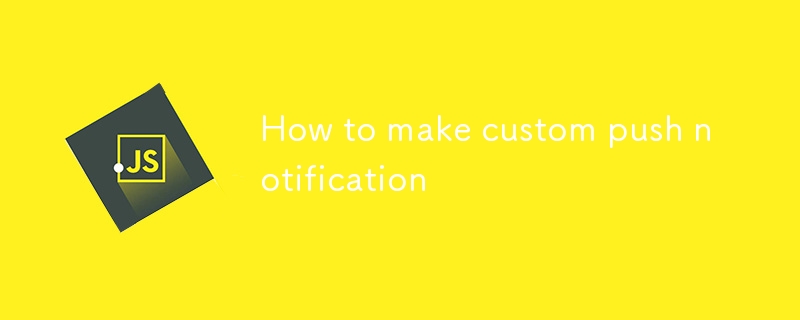Home >Web Front-end >JS Tutorial >How to make custom push notification
How to make custom push notification
- 王林Original
- 2024-08-25 06:38:13778browse

To build a custom push notification system as described, you'll need a variety of technologies, packages, and libraries. Here's a comprehensive list of the tech stack you'll use, divided into client-side, server-side, and general tools.
1. Client-Side (Frontend)
These are the technologies and libraries used in the user's browser.
-
HTML/CSS/JavaScript:
- Standard web technologies to build the frontend of your website.
-
Service Worker:
- Purpose: Handles background tasks, including receiving and displaying push notifications.
- File: service-worker.js.
-
Push API:
- Purpose: Allows the web application to receive push messages sent from the server.
-
Notifications API:
- Purpose: Displays notifications to the user.
-
Web VAPID Library (Optional):
- Purpose: Utility to convert the VAPID public key from Base64 to Uint8Array.
- Package: You may write your own utility function or use an existing library if needed.
2. Server-Side (Backend)
These are the technologies and libraries that run on your server, managing subscriptions, sending notifications, and more.
-
Node.js:
- Purpose: Server-side JavaScript runtime environment to handle backend logic.
- Version: Latest LTS version is recommended.
-
Express.js:
- Purpose: A web application framework for Node.js to build your API endpoints for handling subscriptions, sending notifications, etc.
- Package: express.
-
Web-Push Library:
- Purpose: Handles the creation and sending of push notifications, including VAPID key generation.
- Package: web-push.
npm install web-push --save
-
Database:
- Purpose: Store user subscriptions.
- Options:
- PostgreSQL: A powerful, open-source relational database.
- MySQL: Another popular relational database.
- SQLite: A lightweight, serverless database option.
- ORM (Optional):
- Sequelize: An ORM for Node.js that supports various SQL dialects.
- Package: sequelize for Sequelize.
-
Body-Parser Middleware:
- Purpose: Parse incoming request bodies in middleware before your handlers, available under the req.body property.
- Package: body-parser.
npm install body-parser --save
-
Dotenv:
- Purpose: Load environment variables from a .env file into process.env.
- Package: dotenv.
npm install dotenv --save
3. General Tools and Utilities
-
Nginx or Apache:
- Purpose: Web server to serve your static files and reverse proxy to your Node.js application.
- Setup: Configure to serve your site over HTTPS, which is required for push notifications.
-
SSL Certificate:
- Purpose: Provides HTTPS for your domain, necessary for service workers and push notifications.
- Provider:
- Let's Encrypt: Free SSL certificates.
- Commercial SSL Providers: Paid options available.
-
Git:
- Purpose: Version control for your project.
-
Node Package Manager (NPM) or Yarn:
- Purpose: Manages Node.js packages and libraries.
4. Optional Tools
-
Monitoring Tools:
- Purpose: Monitor server performance and errors.
- Options:
- New Relic, Datadog, Prometheus.
-
Automated Deployment Tools:
- Purpose: CI/CD pipelines for automated deployment.
- Options:
- GitHub Actions, Jenkins, GitLab CI.
-
Database Backup Solutions:
- Purpose: Ensure database backups are made regularly.
5. Development Environment
-
Code Editor:
- Options:
- Visual Studio Code: Popular choice for JavaScript development.
- Sublime Text, WebStorm.
-
Postman or Insomnia:
- Purpose: Testing API endpoints during development.
Summary
Your stack will primarily revolve around JavaScript, Node.js, and Express on the backend, with a database like PostgreSQL or MySQL to store subscription data. The Web-Push library will handle the actual sending of push notifications, and the Service Worker and Push API on the frontend will manage the subscription process and display of notifications.
This setup gives you complete control over the notification system, allowing for customization and optimization according to your needs.
The above is the detailed content of How to make custom push notification. For more information, please follow other related articles on the PHP Chinese website!
Related articles
See more- An in-depth analysis of the Bootstrap list group component
- Detailed explanation of JavaScript function currying
- Complete example of JS password generation and strength detection (with demo source code download)
- Angularjs integrates WeChat UI (weui)
- How to quickly switch between Traditional Chinese and Simplified Chinese with JavaScript and the trick for websites to support switching between Simplified and Traditional Chinese_javascript skills

